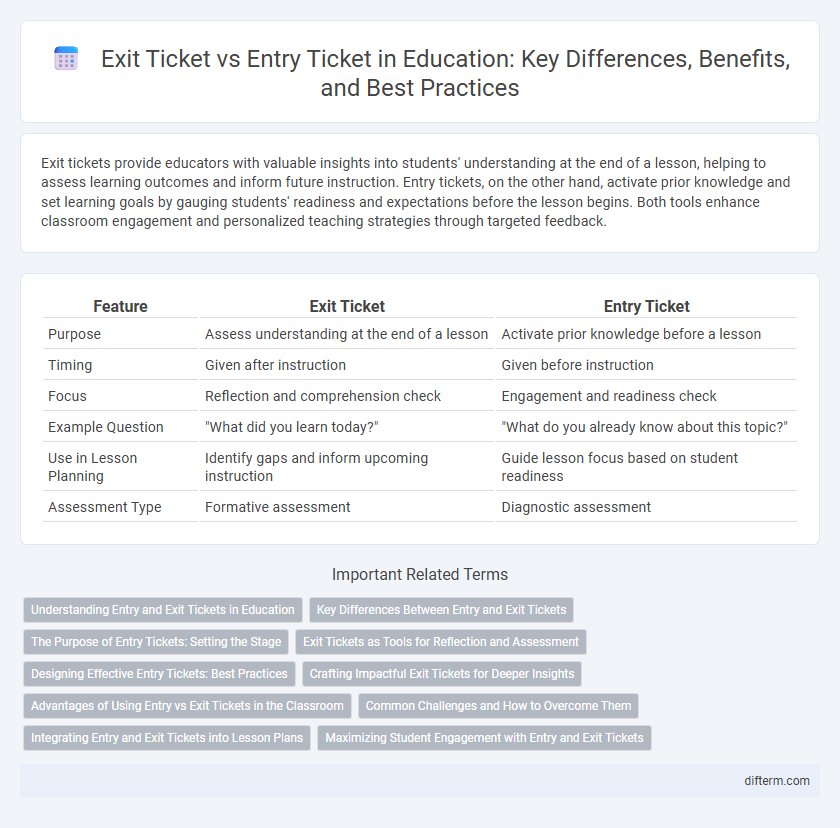Exit tickets provide educators with valuable insights into students' understanding at the end of a lesson, helping to assess learning outcomes and inform future instruction. Entry tickets, on the other hand, activate prior knowledge and set learning goals by gauging students' readiness and expectations before the lesson begins. Both tools enhance classroom engagement and personalized teaching strategies through targeted feedback.
Table of Comparison
| Feature | Exit Ticket | Entry Ticket |
|---|---|---|
| Purpose | Assess understanding at the end of a lesson | Activate prior knowledge before a lesson |
| Timing | Given after instruction | Given before instruction |
| Focus | Reflection and comprehension check | Engagement and readiness check |
| Example Question | "What did you learn today?" | "What do you already know about this topic?" |
| Use in Lesson Planning | Identify gaps and inform upcoming instruction | Guide lesson focus based on student readiness |
| Assessment Type | Formative assessment | Diagnostic assessment |
Understanding Entry and Exit Tickets in Education
Entry tickets assess students' prior knowledge and readiness at the start of a lesson, enabling educators to tailor instruction effectively. Exit tickets measure comprehension and retention by prompting learners to reflect on key concepts before leaving the classroom. Both formative assessment tools enhance instructional strategies and support targeted feedback for improved student learning outcomes.
Key Differences Between Entry and Exit Tickets
Entry tickets activate prior knowledge by prompting students to recall or predict lesson content before instruction begins, while exit tickets assess understanding and retention by requiring students to summarize or reflect on what they have learned after the lesson. Entry tickets often contain questions that gauge readiness and focus, whereas exit tickets provide immediate feedback on learning outcomes and highlight areas needing reinforcement. The strategic use of entry and exit tickets enhances formative assessment, informs instructional adjustments, and supports student engagement throughout the learning process.
The Purpose of Entry Tickets: Setting the Stage
Entry tickets serve as a strategic tool to activate prior knowledge and engage students at the beginning of a lesson, helping teachers gauge readiness and adjust instruction accordingly. These brief, focused prompts encourage critical thinking and set a clear learning objective by connecting new content to existing understanding. Utilizing entry tickets enhances classroom dynamics by fostering immediate participation and establishing a purposeful learning environment.
Exit Tickets as Tools for Reflection and Assessment
Exit tickets serve as essential tools for reflection and assessment by enabling educators to quickly gauge student understanding and identify learning gaps at the end of a lesson. These concise prompts encourage students to summarize key concepts, articulate questions, and provide feedback, fostering metacognitive skills and promoting active engagement. Data collected from exit tickets inform instructional adjustments, personalize learning experiences, and enhance overall educational outcomes.
Designing Effective Entry Tickets: Best Practices
Designing effective entry tickets involves crafting concise, targeted questions that activate prior knowledge and set clear learning objectives for the lesson. Incorporating formative assessment strategies ensures entry tickets yield actionable insights, allowing educators to tailor instruction dynamically. Utilizing technology tools like digital polls or quizzes enhances engagement and data collection for more precise feedback on student readiness.
Crafting Impactful Exit Tickets for Deeper Insights
Crafting impactful exit tickets involves designing concise, targeted questions that effectively gauge student understanding and inform future instruction. Exit tickets provide immediate feedback on lesson comprehension, highlighting areas needing reinforcement or extension, unlike entry tickets which primarily assess prior knowledge. Utilizing data-driven exit ticket strategies enhances teaching responsiveness and fosters deeper insights into student learning progress.
Advantages of Using Entry vs Exit Tickets in the Classroom
Entry tickets activate prior knowledge and set clear learning objectives, helping students focus and prepare mentally for new content. Exit tickets provide immediate feedback to teachers about student understanding, enabling timely adjustments to instruction and reinforcing key concepts. Both tools enhance formative assessment, promote student engagement, and support differentiated learning strategies in the classroom.
Common Challenges and How to Overcome Them
Educators often face challenges with exit and entry tickets, such as time constraints and student engagement, which can hinder effective assessment and feedback. To overcome these issues, implementing concise prompts aligned with learning objectives and utilizing digital tools can streamline the process and increase student participation. Providing clear instructions and incorporating varied question formats ensures accurate measurement of student understanding and readiness for the lesson.
Integrating Entry and Exit Tickets into Lesson Plans
Integrating entry and exit tickets into lesson plans enhances formative assessment by capturing students' prior knowledge and gauging understanding after instruction. Entry tickets engage learners at the start, activating relevant schemas, while exit tickets provide immediate feedback on lesson effectiveness and identify areas needing reinforcement. This dual strategy supports differentiated instruction and informs data-driven decisions to improve student learning outcomes.
Maximizing Student Engagement with Entry and Exit Tickets
Entry tickets activate prior knowledge and set learning objectives, effectively preparing students for new content at the start of a lesson. Exit tickets provide immediate feedback on student understanding and help educators adjust future instruction based on assessment data. Utilizing both entry and exit tickets maximizes student engagement by creating interactive, reflective learning experiences that promote continuous assessment and tailored teaching strategies.
exit ticket vs entry ticket Infographic

 difterm.com
difterm.com